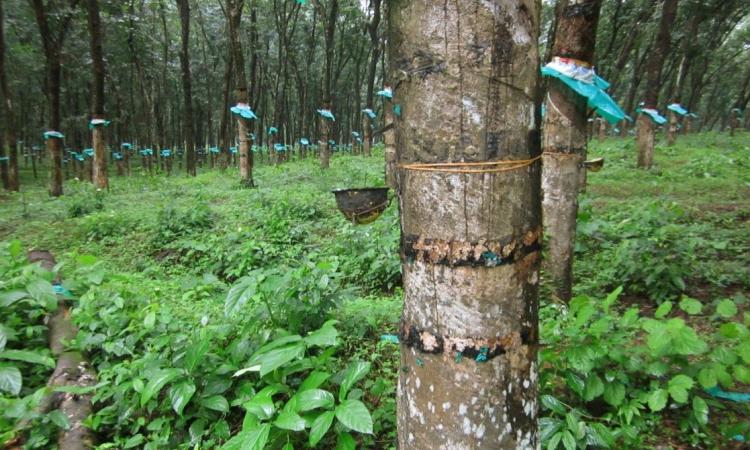
People tend to be happier and reinvigorated in green spaces. Agrobiodiversity - the number and abundance of different species in particular systems is known to promote happiness. It ensures the resilience of ecosystem services such as food production, climate regulation, and pest management that in turn underpin human wellbeing. A paper ‘Is rubber monoculture banishing agrobiodiversity and happiness? Evidences from shifting cultivation landscape of Tripura, northeast India’ in Current Science assesses the status of agrobiodiversity and subjective well-being of an indigenous community amidst the transition from shifting cultivation to monoculture of natural rubber.
Does rubber monoculture create the ideal ambience to make people happy?
The study was done in the remotely located state of Tripura in northeast India. It uses mixed methods research for in depth investigation of respondents sampled from 18 villages of Dhalai district of the state. The area was previously marked by shifting cultivation, alternately called slash-and burn agriculture (locally jhum), an extensive farming system that safeguarded the area’s ecosystems, livelihoods, culture and food security.
The government’s ill-conceived view that the system is ruinous led to its control through various measures such as ban, forced resettlement, declaration of forest reserves, monetary incentives, crop substitution etc. This in turn led to depletion of the forest resources and related ecology.
Various programmes promoted land use changes for conversion of shifting cultivation landscapes to rubber (Hevea brasiliensis) plantation. The promotion of monoculture brought in economic benefits, but had several negative social and environmental impacts.
Transition from shifting cultivation to natural rubber plantation
The study findings revealed that in the shifting cultivation landscape of the area, the cultivated crop species and livestock breeds were being largely replaced by rubber plantation. Only 19 crop species could be documented in the landscape that was otherwise known for its vast agrobiodiversity in the tropics.
Rubber is a tropical crop and grows well in Tripura, which is the second largest producer of natural rubber in India. Since 1976, there was emphasis on rubber production in the state. The thrust on rubber plantations was strengthened with the launch of the World Bank aided project which led to an increase in area under natural rubber by 89% and a decrease in area under shifting cultivation by 63% in Tripura between 2000–2001 and 2010–2011. It was the highest rate of growth of rubber plantation during the period as compared to any other state.
A decline in the rate of crop species/landraces, availability of wild edible plants and reduction in ecosystem services in shifting cultivation landscape was perceived by the study respondents. Findings on ecosystem services, i.e. the benefits they provided, which were rendered by the shifting cultivation landscape in the past, showed that they had severely degraded and declined due to shrinking of biodiversity in the landscape.
Further, half of the species and their landraces were squeezed in the sample area over a period of time. This was due to altered food preference among new generation as well as market oriented production mainly for cultivation of cash crops. The study documented only 19 crops species and 3 livestock species in the shifting cultivation landscape, which is rich normally in terms of agrobiodiversity.
Over 90% respondents reported their subjective well-being as ‘struggling’ or just ‘getting by’. In other words, they are compelled to manage or continue to exist in a state or situation where something is lacking. They were either struggling in the present, or expecting more struggle in future. Such people are less likely to eat healthy food and more likely to indulge in drinking and smoking.
In many ethnic cultures, the non-material cultural practice of shifting cultivation is intimately associated with the social order, with authority and decision-making powers over resource access and allocation as well as with festivals, rituals and the sense of sacred. There are often reciprocal collective labour activities around the cultivation calendar such as collective clearing, fire management, collective harvesting and so on, whereas, natural rubber monoculture weans away all these activities. Cultural services are deeply interconnected with each other and often connected to provisioning and regulating services.
The study results revealed that in the natural environment settings, tribal people tended to be happier and reinvigorated and also found that all green spaces were not equal in promoting happiness and sustaining ecosystem services which depended on biodiversity and ecosystem functions.
The full report can be accessed here